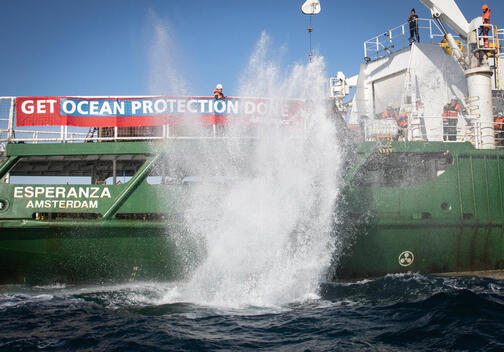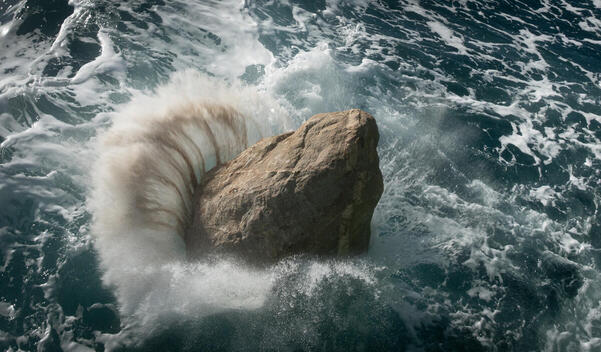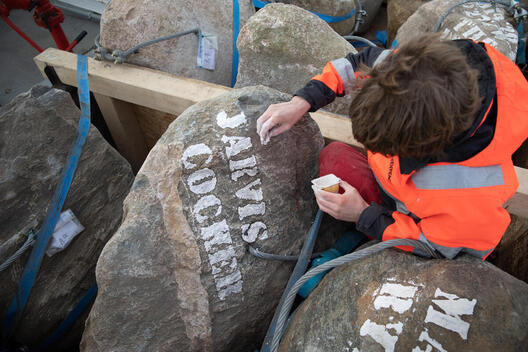Activists from Greenpeace have built an underwater boulder barrier to protect the Offshore Brighton Marine Conservation Zone from bottom dredging by trawlers.

Greenpeace dropped boulders from the MY Esperanza to build a barrier aimed at protecting the Offshore Brighton area from bottom-dredging trawlers
The environmental charity said that it was dropping boulders in the area – which is eight times the size of Brighton and Hove – because the government had left 97 per cent of the protected areas in British waters open to destructive bottom trawling.
Near inshore waters off Sussex, including Brighton and Hove, have also been given some legal protection, with the approval of a new byelaw.
![]()
Greenpeace said: “Activists on the Greenpeace ship Esperanza have built a new underwater boulder barrier in the Offshore Brighton marine protected area in the English Channel, one of the UK’s most heavily bottom trawled protected areas.
“This follows Greenpeace’s Dogger Bank boulder barrier and will close 55 square nautical miles of Offshore Brighton, one fifth of its total area, to destructive bottom trawling.
“Celebrities including Thandie Newton, Hugh Fearnley-Whittingstall, Paloma Faith, Bella Ramsey, Mark Rylance, Jarvis Cocker and Ranulph Fiennes have signed their names to boulders.
“In response to Greenpeace’s Dogger Bank boulder barrier, the UK government announced new byelaws which would totally close the Dogger Bank and South Dorset protected areas and partially close two other protected areas to bottom trawling.
“This piecemeal approach would still leave 97 per cent of UK offshore protected areas, or 74 out of 76, fully or partially open to bottom trawling.
“Bottom trawlers spent 3,099 hours fishing in Offshore Brighton in 2019. Offshore Brighton was established in 2016 to protect its seabed habitat which is being destroyed by bottom trawling.
“According to the government, Offshore Brighton is ‘unlikely to be moving towards conservation objectives’.
“The government taking steps to restrict bottom trawling in a handful of protected areas demonstrates some political will, following Brexit, to properly protect the UK’s offshore waters.
“This was previously difficult because introducing restrictions on fishing operations in offshore UK waters required agreement from other EU member states.”
Greenpeace UK oceans campaigner Chris Thorne said from on board the Esperanza: “Offshore Brighton is the perfect monument to our government’s failure to protect our seas.
“It exists specifically to protect the seabed but bottom trawlers spend thousands of hours each year ploughing this sensitive habitat.
“The government’s move to properly protect just two of the UK’s protected areas barely touches the tip of the iceberg in terms of what is needed to save our oceans.
“All of the UK’s protected areas need real protection, not just a handful.
“This government is supposed to be showing global leadership on ocean conservation and fighting for 30 per cent of the world’s oceans to be protected.
“But it can’t even properly protect 30 per cent of our own waters.

Greenpeace dropped boulders from the MY Esperanza to build a barrier aimed at protecting the Offshore Brighton area from bottom-dredging trawlers
“The move to stop bottom trawling in the Dogger Bank proves the UK government can stop destructive industrial fishing if it wants to.
“The government must show more ambition in a year when it is supposed to display global leadership on solving the climate and nature emergencies.
“It must urgently ban destructive industrial fishing from all of the UK’s protected areas at sea by restricting fishing vessel licenses.”
Hugh Fearnley-Whittingstall, whose name was on one of the boulders dropped from the MY Esperanza, said: “I’m proud to have had the chance to put my name on one of these boulders.
“This action will play a small but significant role – and far more than our government has so far done – to actually protect Offshore Brighton in a pragmatic and effective way.
“However, this shouldn’t be necessary. Our fervent hope is that our government will now turns words into action, paper parks into real conservation and properly protects our oceans”

Greenpeace dropped boulders from the MY Esperanza to build a barrier aimed at protecting the Offshore Brighton area from bottom-dredging trawlers
Greenpeace added: “Most of the UK’s protected areas in offshore waters (those more than 12 nautical miles from the coast) were established to protect the seabed.
Currently, there are no full bottom trawling bans in any of the UK’s offshore protected areas.
“Data released by Oceana last year revealed that 97 per cent of the UK’s offshore marine protected areas are being bottom trawled.
“Greenpeace informed the relevant marine authorities of the co-ordinates of each boulder to ensure navigational safety for other seafarers.
“Greenpeace also commissioned an independent scientific agency, BioLaGu, to conduct a Natura 2000 Environmental Impact Assessment to determine the impact of this activity.
“The assessment concluded the activity would not have a significant impact on the protected features of Offshore Brighton.

Jarvis Cocker was among those to give their names to boulders dropped in the Offshore Brighton area by Greenpeace
“Greenpeace’s activity will prevent bottom trawling in part of the Offshore Brighton protected area. Vessels which fish here will still be able to operate elsewhere.
“It is scientifically proven that fully or highly protected marine areas lead to significant spill-over benefits for the wider marine ecosystem, helping safeguard and boost fish stocks both within and outside the protected area.
“A network of fully or highly protected marine areas would help UK fishing communities by ensuring there are healthy oceans, full of fish, for generations to come.
“Greenpeace is committed to achieving proper protection for all of the UK’s marine protected areas. “A Greenpeace report, Bright Blue Seas, released in August 2020 revealed that the majority of the UK’s offshore marine protected areas are failing to meet conservation targets, and almost every offshore marine protected area has no site condition monitoring in place.
“Greenpeace is calling on the government to ban bottom trawlers and supertrawlers from fishing in all of the UK’s marine protected areas.
“Last year, 84 MPs from across Parliament (including 29 Conservative MPs) signed a Greenpeace-co-ordinated open letter, calling on the Secretary of State George Eustice to ban destructive industrial fishing from UK marine protected areas.
“The UK government should implement this by immediately restricting vessel licences to operate in protected areas, as opposed to following the slow local byelaw approach being employed for the Dogger Bank, which does not reflect the urgency of the climate and nature emergencies.”


